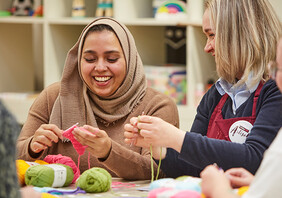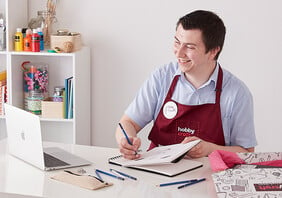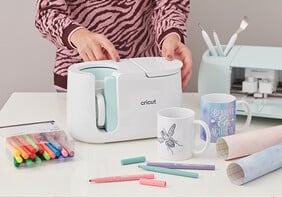How to Experiment with Mixed Media and Acrylic Mediums
Sometimes branching out into new mediums and techniques can be daunting. Follow the step-by-step guide to see what products and techniques can create beautiful artwork.
Explore the endless possibilites of acrylic and mixed media art.
Project and instructions by Sophie Bridgland
You will need
You will also need:
* Spray Paint - available in store at Hobbycraft
To create unique, creative mixed media paintings, I like to keep an open mind when it comes to materials. If it can be glued, painted, or poured onto a canvas, then it sounds good to me!
For an example, I will be taking you through the creating process of my recent painting “Honeymoon”.
When starting a new piece, I often like to start without knowing what I'm going to paint or how I'm going to paint it. This may seem quite daunting, especially if you are new to painting, but the more you practise the art of experimentation, the more you will begin to understand how the materials react with each other, and it should come more naturally

So instead of coming up with an idea, I think of a feeling, or message that I want to get across, which I then translate into colour. In this particular moment, the sun was shining, and it was a very hot day, so I chose to create the appearance of warmth. I picked out shades of warm browns, golds, oranges and yellow.

To start the background, I like to get the colours on the canvas in any means possible, whether by brush, palette knife, hands, or sometimes using something random like a leaf can be fun. In this case, I used a palette knife to add the colours thickly – which will help to create texture later on.
Some artist's choose to avoid heavy colours like black, however I find that starting with an intense, dark background gives the painting a lot of depth, especially when you begin to add the highlights on top to create lovely contrast.


Once the colours are on the canvas, I begin to experiment using the Pebeo mixed media products.
I first used a spray bottle to wet the top layer of paint, which allowed some of the colours to blend into each other. It results in a similar effect to acrylic paint pouring, except doing it this way allows some of the texture to remain.



When you pour the mixed media products on to the layer of water, the chemicals spread apart and create interesting patterns on top of the water. It should dry overnight, but it can sometimes take longer.
This type of art is definitely a process, but I love how it has it's own little journey to get to the finished result.

Once dry, this is where I stand back and decide what I'm going to paint. The warm browns and golds in this piece seemed very romantic to me, which led me to the idea of painting roses, to continue on with that theme.



Before I start painting, I sometimes like to draw a quick sketch to give me an idea of the composition.
I then sketch the main outlines of the roses onto the actual canvas, and to do this I have recently been using the posca 'paint in a pen' in white, as you'll find that pencil won't always show up on mixed media surfaces.


Once outlined, I start by using modelling paste to give even more texture to the roses.
This step is one that I'll use depending on the subject matter – some paintings don't need it, but in this case I felt that the roses would need some help in coming forward from the background.

When it dried, I started to paint the roses with acrylic paint using tones of white, gold and browns to create creamy white petals. I continued to use darker browns to paint the stems and leaves, and any other details I felt it needed.



Now the painting could be left here, but I always like to finish with some decorative touches.
It's completely personal what you want to add at this point, but some of my favourite products to use include Pebeo Vitrail cerne relief paste, and Pebeo Gilding wax, as they add beautiful metallic areas that will shine in the sunlight.









